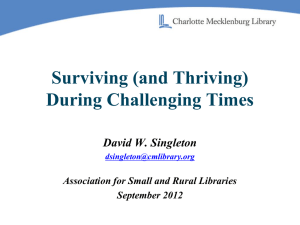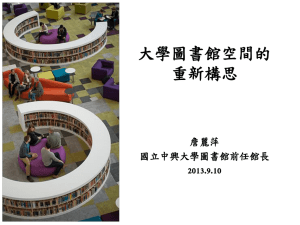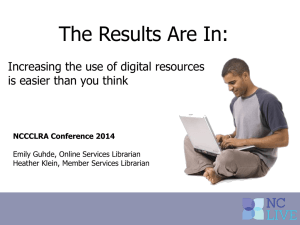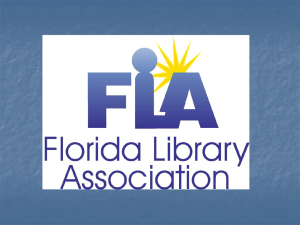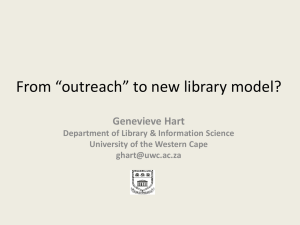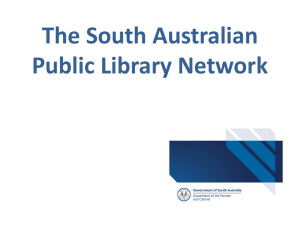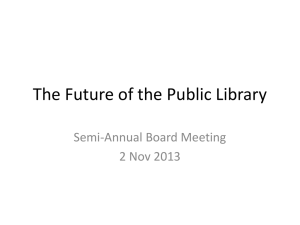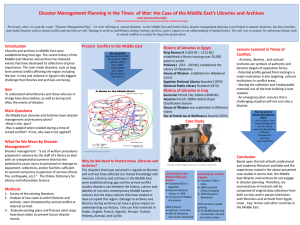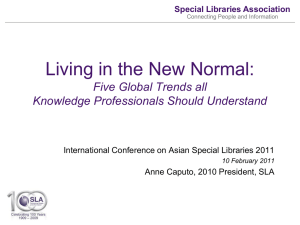NY Slide Presentation as Powerpoint
advertisement
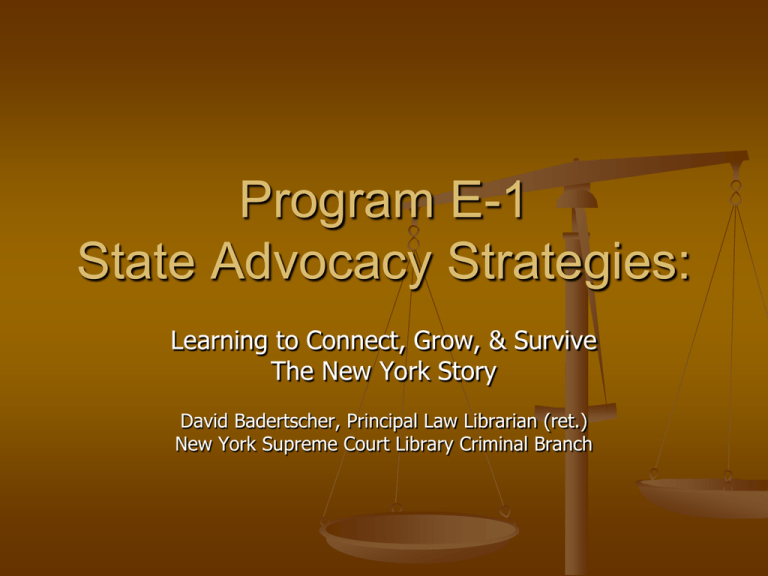
Program E-1 State Advocacy Strategies: Learning to Connect, Grow, & Survive The New York Story David Badertscher, Principal Law Librarian (ret.) New York Supreme Court Library Criminal Branch The New York Story 1818. New York State Library established. 1846. New York Court of Appeals in its present form by the New York Constitutional Convention of 1846. See Article 2 Section 6 of the NY Constitution and NY L.1847, Ch. 280. 1894. New York Supreme Court Appellate Divisions established in present form. Created by the Constitutional Convention of 1894. 1955. Judicial Conference created in 1955. Provided a forum within which judges could talk together and discuss court and administration issues within a statewide organizational framework. Conference Commissioned first known statewide study of New York Court Libraries. Report was released in 1961. 1962-1978. Since 1962 Section 1 of Article VI of the New York State Constitution has proclaimed there shall be a Unified Court System for the State but NYUCS was not fully implemented in its present form until enactment of the Unified Court Budget Act in 1976, effective April 1, 1978. The New York Story (continued) 1978. New York State Governor’s Commission on Libraries, Conference on Libraries convened in Albany, June 5-7, 1978. Court librarians participated and a resolution advocating inclusion of court libraries within a broader statewide network was submitted. 1982. Office of Chief Librarian established within the New York State Unified Court System. In approximately 2001, that Office joined the Division of Court Operations, currently the Division of Professional and Court Services. 1983. New York State Unified Court Law Libraries Association (Pro Se) established as a library association for New York Court libraries. 1993. The Court Libraries Act of 1993 provides that each county in New York have a court library with access to the general public. See Judiciary Law Sections 813 and 814 L. 1993 Ch. 662. At present (2012), this Act is being implemented primarily through designated court public access law libraries, or in counties without such libraries, through other arrangements, such as placing appropriate legal reference materials in a local public library. Library Administrative Structure within the N.Y.U.C.S. The New York State Unified Court System operates and maintains a variety of libraries. Some libraries primarily serve their courts and agencies with little or no public access. Others, while serving their courts are designated Public Access. A third category, while not so designated, supports these Public Access branches. Office of Court Administration (OCA) Division of Professional & Court Services Office of Legal Information Law Libraries Legal Research Information Management District Administration Local Administration Boards of Trustees for Public Access Law Libraries Public Access Law Libraries 62 Public Access Law Libraries: 1 Per County Public Access Law Library Collections: Cases, Statutes, Databases, Online Catalogs Public Access operate under oversight of Boards of Trustees For current list of Public Access Law Libraries of the New York Courts, see: http://www.courts.state.ny.us/lawlibraries/public access.shtml Individual Law Libraries As Advocates Each library endeavors within its means and needs to advocate individually – in addition to resources & services provided in daily operations – examples: DIY self-represented program awareness and instruction Writing for local Bar Association newsletters or other legal audience periodicals Local library publications, e-news etc. Sponsoring CLE classes within the libraries Implementing OLI initiatives Participating in professional associations and activities Establishing collaborative relationships as needed with other departments within the court system Investigating the possibility of establishing not-for-profit entities outside the regular structure of the court system to provide financing and other support to public access libraries beyond that available through the New York Unified Court System Office of Legal Information As Advocate Public access law libraries work with the Office of Legal Information. OLI advances law library advocacy through: Development of Online Collections Information Gathering Forming Cooperatives within UCS Web-based Training & Remote Access Capabilities Document Delivery for the Public Reviewing Print Materials to Meet Needs & Avoid Duplication Reviewing Electronic Vendor Agreements E-Mail Help Desks & Reference Service Digital Projects Under Review Improving Advocacy Efforts Within the N.Y.U.C.S. Those responsible for implementing library policy within the N.Y.U.C.S. need to: Give urgent attention to improving communication and collaboration among all members of the court library community - libraries, courts, court administration, and such organizations as the New York State Unified Court Law Libraries Association (Pro Se) - all need to be involved as stakeholders in this joint effort to build a strong advocacy program. Consider some type of consortium arrangement such as we have been hearing about, but that will first require careful study. Improving Advocacy Efforts Outside the N.Y.U.C.S. Collaborative efforts and advocacy initiatives with outside organizations are important—especially in hard times. American Association of Law Libraries - first and foremost among such organizations and--as we already know--has already been enormously helpful and effective. LLAGNY and ALLUNY, our local AALL chapters, continue working closer to home to further these efforts in New York State. Reference and Research Library Systems in New York State (3R’s) New York Library Association - which has developed a series of talking points on library advocacy. New York Library Council (one of the 3’Rs) - has developed a list of resources for library advocacy. State of New York Board of Regents - which this last April released a Report, entitled, Creating the Future: A 2020 Vision and Plan for Library Service in New York State. This Report contains a number of recommendations of interest to all libraries and librarians. New York Summary Outreach Within the Court Community Improve communication & collaboration Identify options for consortium arrangements Outreach Within the Library Community AALL / LLAGNY / ALLUNY NY Reference & Research Library Systems 3Rs New York Library Association New York Library Council Outreach With our Library Patron Base Identify patron groups / needs / services Advocacy Factors STRUCTURE: Important at all levels – Systems, interlibrary cooperation, libraries and other organizations – Think of structure as the underlying girders upon which all library programs and initiatives, including advocacy initiatives are carried out. COORDINATION: Coordination of goals, objectives, activities, services and other initiatives. COLLABORATION: Developing and maintaining two way collaborative relationships that are reciprocal at all levels. COMPETITION: Be prepared to deal with competition. It is always present in some form. VIGILANCE: Being alert to both opportunities and set backs and being prepared to deal with either. Maintaining a consistently high level of service. STRATEGY: Thinking strategically when both developing and carrying out advocacy programs. Assess risk strategically. Thinking strategically when preparing and presenting budgets. TRUST AND AUTHENTICITY: Libraries and library systems will only remain viable so long as patrons perceive that service provided is consistently dependable and that information acquired, stored and disseminated by these institutions is both trustworthy and authentic. This means, that personnel and other resources-including management support necessary to meet this standard-must be provided on an ongoing, long term basis. CREATIVITY AND RESOURCEFULNESS. Being prepared to "think outside the box." Being flexible and adaptable. The Sustainable 21st Century Law Library “The second decade of the Twenty-first Century is a time of challenge and opportunity for law libraries across the country. As the justice system re-orients itself from one only designed to decide cases to one responsible for providing access to justice for all, and as technologies transform access to legal information, law libraries will have no choice but to re-assess, re-design, and repurpose towards a broad access to justice mission.” (Zorza, Richard. The Sustainable Twenty-first Century Law Library: Vision, Deployment and Assessment for Access to Justice, 2012.http://zorza.net/LawLibrary.pdf) New York State Regents Council “We live in interesting times. Each and all of us are assaulted by a cacophony of noise and an overload of information. We’ve all heard the comment ‘Who needs libraries? Information is free online.’ It may well be…but wisdom and knowledge are not. And that is why civilization has cherished its libraries for over four thousand years. Whatever the question, whoever asks it, and in whatever format the answer resides; libraries are there to help show the path to understanding and hopefully the creation of new knowledge as well.” (Nichols, Gerald. Testimony to the Regents Cultural Education Committee, April 2012 http://www.nysl.nysed.gov/libdev/adviscns/rac/2012testimony.htm) ADDITIONAL REFERENCE – ADVOCACY RESOURCES NY: Association of Law Libraries of Upstate New York ALLUNY – Government Relations Committee: http://www.aallnet.org/chapter/alluny/comms.asp Law Library Association of Greater New York (LLAGNY) – Government Relations Committee: http://www.aallnet.org/chapter/llagny/committees/GovtRelations.html New York Library Association - Advocacy: http://www.nyla.org/displaycommon.cfm?an=7 New York Metropolitan Library Council (METRO): http://metro.org/advocacy/
